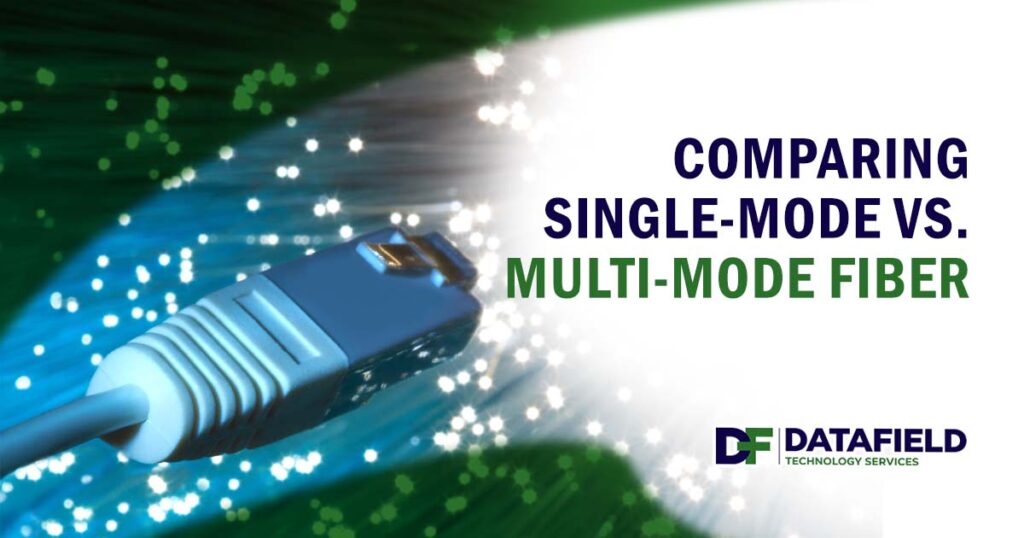Fiber optic technology is essential for modern networking, offering high-speed data transmission with minimal signal loss. Businesses and IT professionals must choose between single-mode and multi-mode fiber when selecting fiber optic cables. Each type has distinct advantages based on speed, distance, and cost. Understanding these differences helps network engineers, telecom professionals, and IT managers make informed decisions.
Understanding Single-Mode vs. Multi-Mode Fiber
What Is Single-Mode Fiber?
Single-mode optical fiber has a small core diameter, typically around 8-10 microns. It transmits light using a single optical path, reducing signal dispersion and allowing data to travel long distances with minimal loss. This makes single-mode fiber ideal for high-speed, long-haul telecommunications, enterprise networks, and large-scale data centers.
Key characteristics of single-mode fiber include:
- Smaller core size, allowing a single light path
- High bandwidth and low attenuation over long distances
- Compatibility with laser-based light sources
- Higher initial cost but lower long-term maintenance
What Is Multi-Mode Fiber?
Multi-mode fiber has a larger core diameter, usually 50-62.5 microns, which allows multiple light paths to travel simultaneously. This results in more excellent signal dispersion, limiting transmission distance compared to single-mode fiber. Multi-mode fiber is commonly used for short-range data transmission within buildings, campus networks, and data centers.
Key characteristics of multi-mode fiber include:
- Larger core size, supporting multiple light paths
- Lower cost of deployment and equipment
- Limited transmission range due to modal dispersion
- Typically used with LED or VCSEL light sources
Key Differences: Single-Mode vs. Multi-Mode Fiber
Speed and Bandwidth Capabilities
Single-mode and multi-mode fiber support high-speed data transmission, but their performance varies based on distance and application.
- Single-mode fiber supports higher bandwidth and faster speeds over long distances. It is commonly used in telecommunications, enterprise networks, and high-speed internet backbones where long-range data transmission is required.
- Multi-mode fiber provides high-speed connectivity over short distances but experiences more signal loss due to modal dispersion. It is well-suited for local area networks (LANs), data centers, and intra-building connections.
Distance and Signal Loss Comparison
Distance limitations are a key factor in choosing between single-mode and multi-mode fiber.
- Single-mode fiber can transmit data over distances exceeding 100 km without significant signal degradation, making it ideal for large-scale networks and metro-area connections.
- Multi-mode fiber is limited to short distances—typically up to 550 meters for 10 Gbps transmission. Beyond this range, signal quality deteriorates, requiring repeaters or conversion to single-mode fiber.
Cost Considerations: Installation and Maintenance
Cost is another critical factor when selecting between single-mode and multi-mode fiber.
- Single-mode fiber requires more expensive laser-based transmitters and precise installation, leading to higher initial costs. However, its durability and lower maintenance requirements can reduce long-term expenses.
- Multi-mode fiber has lower upfront costs due to its compatibility with inexpensive LED or VCSEL light sources. However, its shorter range may require additional network hardware, increasing overall expenses in large deployments.
Industry Applications: Who Uses Single-Mode vs. Multi-Mode Fiber?
Industries That Benefit from Single-Mode Fiber
Single-mode fiber is preferred for industries requiring long-distance, high-speed data transmission with minimal signal loss.
- Telecommunications and Internet Service Providers (ISPs): These are used in backbone networks to support long-distance communication with high bandwidth and reliability.
- Enterprise and Cloud Data Centers: Essential for high-speed connections between data centers, reducing latency and improving scalability.
- Government and Military Networks: Used for secure, long-range communication infrastructure requiring high-performance fiber optic connections.
- Healthcare and Research Institutions: Supports high-speed data transmission for imaging, diagnostics, and research applications that require uninterrupted connectivity.
Industries That Benefit from Multi-Mode Fiber
Multi-mode fiber is widely used in environments where shorter distances and cost efficiency are key factors.
- Campus and Office Networks: These are ideal for connecting buildings within a campus or an office environment where transmission distances are limited.
- Data Centers: Used for short-range connections between servers, storage systems, and networking equipment.
- Industrial and Manufacturing Facilities: Supports automation, sensor networks, and machine-to-machine communication in controlled environments.
- Educational Institutions: Provides reliable high-speed internet connectivity for classrooms, research labs, and administrative networks.
How DataField Helps Businesses Optimize Fiber Networks
Choosing between single-mode and multi-mode fiber depends on business requirements, network size, and budget. DataField specializes in designing and deploying fiber optic solutions tailored to business needs.
- Network Assessment: Evaluating current and future networking requirements to recommend the best fiber optic solution.
- Custom Design and Installation: Deploying optimized fiber networks for data centers, enterprise environments, and telecom providers.
- Scalability and Performance Optimization: Ensuring fiber infrastructure supports business growth and high-bandwidth applications.
Talk to a Fiber Expert About Your Network Needs
The right fiber optic technology is crucial for long-term network performance and efficiency. Contact DataField for expert guidance on choosing between single-mode and multi-mode fiber. Their team provides professional consultation and customized solutions to meet business networking requirements.


